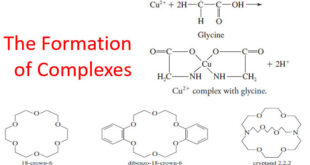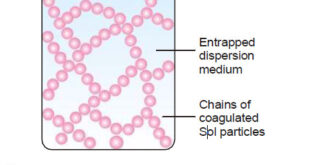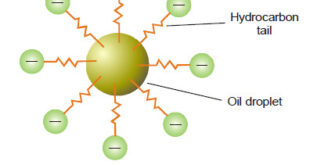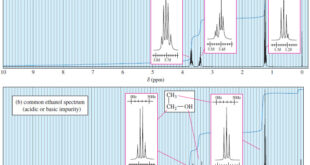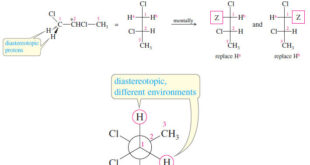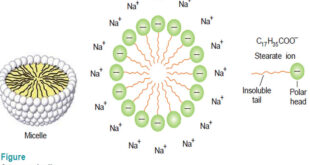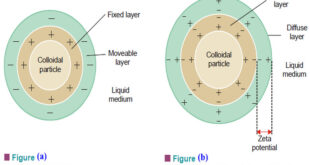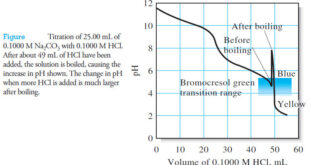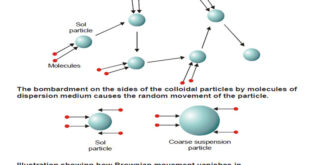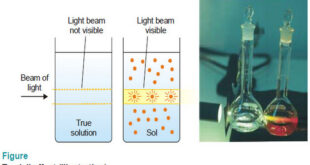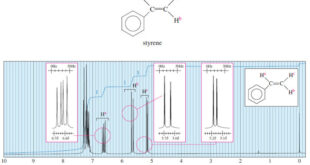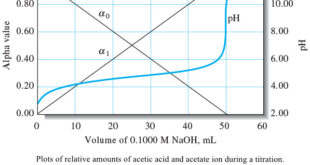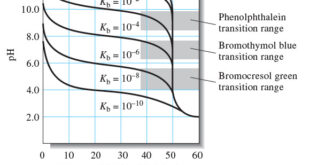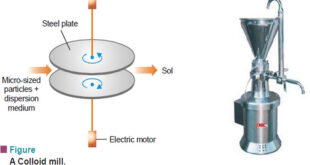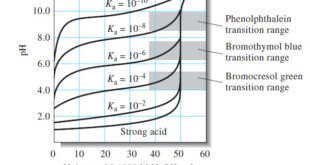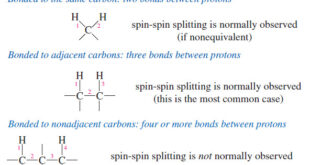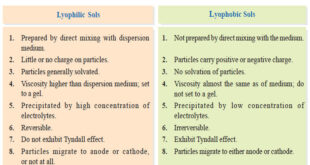Structure of Amino acids – Although more than 300 different amino acids have been described in nature, only 20 are commonly found as constituents of mammalian proteins. – Each amino acid (except for proline, which has a secondary amino group) has a carboxyl group, a primary amino group, and a …
Read More »Carbon-13 NMR Spectroscopy
– In this topic, we will discuss The Carbon-13 NMR Spectroscopy. Carbon-13 NMR Spectroscopy – Where does a carbonyl group absorb in the NMR? Where does an internal alkyne absorb? – In the proton NMR, both of these groups are invisible. Sometimes we can infer their presence: If the carbonyl …
Read More »The Formation of Complexes
The Formation of Complexes – Most metal ions react with electron-pair donors to form coordination compounds or complexes. – The donor species, or ligand, must have at least one pair of unshared electrons available for bond formation. – Water, ammonia, and halide ions are common inorganic ligands. In fact most …
Read More »Gels : Defination, Types, Properties
– In this topic, we will discuss The Gels : Defination, Types, and Properties. What are Gels? – A gel is a jelly-like colloidal system in which a liquid is dispersed in a solid medium. – For example, when a warm sol of gelatin is cooled, it sets to a …
Read More »Emulsions : Defination, Types, Examples, Preparation
Defination of Emulsions – Emulsions are liquid-liquid colloidal systems. – In other words, an emulsion may be defined as a dispersion of finely divided liquid droplets in another liquid. – Generally one of the two liquids is water and the other, which is immiscible with water, is designated as oil. …
Read More »Time Dependence of NMR Spectroscopy
– In this topic, we will discuss The Time Dependence of NMR Spectroscopy. Time Dependence of NMR Spectroscopy – We have already seen evidence that NMR does not provide an instantaneous picture of a molecule. – For example, a terminal alkyne does not give a spectrum where the molecules oriented …
Read More »Applications of Neutralization Titrations
– In this topic, we will discuss The Applications of Neutralization Titrations. Typical Applications of Neutralization Titrations – Neutralization titrations are used to determine the many inorganic, organic, and biological species that possess acidic or basic properties. – In addition, however, there are nearly as many applications in which the …
Read More »Stereochemical Nonequivalence of Protons in NMR Spectroscopy
– In the this topic we talk about Stereochemical Nonequivalence of Protons in NMR Spectroscopy. Stereochemical Nonequivalence of Protons – Stereochemical differences often result in different chemical shifts for protons on the same carbon atom. – For example, the two protons on C1 of allyl bromide (3-bromopropene) are not equivalent. …
Read More »Associated Colloids
– In this subject, we will discuss the Associated Colloids. Associated Colloids – The molecules of substances as soaps and artificial detergents are smaller than the colloidal particles. However in concentrated solutions these molecules form aggregates of colloidal size. – Substances whose molecules aggregate spontaneously in a given solvent to …
Read More »Electrical Properties of Sols
Electrical Properties of Sols – In this topic we will discuss the Electrical Properties of Sols as follow: (1) The sol particles carry an electric charge. (2) Electrophoresis. (3) Electro-osmosis. (4) Coagulation or Precipitation. (5) Protective action of sols. (6) Origin of charge on sol particles. (1) The sol particles …
Read More »Reagents for Neutralization Titrations
– In this subject, we will discuss the Reagents for Neutralization Titrations. Reagents for Neutralization Titrations – we noted before that strong acids and strong bases produce the largest change in pH at the equivalence point. – For this reason, standard solutions for neutralization titrations are always prepared from these …
Read More »Kinetic Properties of Sols – Brownian movement
Kinetic Properties of Sols – In this topic, we will discuss Kinetic Properties of Sols. Brownian Movement – When a sol is examined with an ultramicroscope, the suspended particles are seen as shining specks of light. – By following an individual particle it is observed that the particle is undergoing …
Read More »Optical Properties of Sols
Optical Properties of Sols – In this topic, we will discuss Optical Properties of Sols as follow: Sols exhibit Tyndall effect Ultramicroscope shows up the presence of individual particles Sol particles can be seen with an Electron microscope (1) Sols exhibit Tyndall effect – When a strong beam of light …
Read More »Complex Splitting in ¹H NMR Spectra
– In the last topic we talk about Spin-Spin Splitting in ¹H NMR Spectra, but In this topic, we will discuss The Complex Splitting. Complex Splitting in ¹H NMR Spectra – There are many cases of complex splitting, where signals are split by adjacent protons of more than one type, …
Read More »The Composition of Solutions During acid/Base Titration
– In this topic, we will discuss The Composition of Solutions During acid/Base Titration. The Composition of Solutions During acid/Base Titration – We are often interested in the changes in composition that occur while a solution of a weak acid or a weak base is being titrated. – These changes …
Read More »Titration Curves for Weak Bases
– In this topic, we will discuss The titration Curves for Weak Bases. Titration Curves for Weak Bases – The calculations needed to draw the titration curves for weak bases are analogous to those of a weak acid, as shown in The following Example . A 50.00-mL aliquot of 0.0500 …
Read More »Preparation of Sols and Purification of Sols
– In this topic, we will discuss Preparation of Sols, Purification of Sols and its colors Preparation of Sols – Lyophilic sols may be prepared by simply warming the solid with the liquid dispersion medium e.g., starch with water. – On the other hand, lyophobic sols have to be prepared …
Read More »Titration Curves for Weak Acids
Titration Curves for Weak Acids – Four distinctly different types of calculations are needed to compute values for a weak acid (or a weak base) titration curves: (1) At the beginning, the solution contains only a weak acid or a weak base, and the pH is calculated from the concentration …
Read More »Spin-Spin Splitting in ¹H NMR Spectra
– In this topic, we will discuss The Spin-Spin Splitting in ¹H NMR Spectra. Theory of Spin-Spin Splitting – A proton in the NMR spectrometer is subjected to both the external magnetic field and the induced field of the shielding electrons. – If there are other protons nearby, their small …
Read More »Lyophilic and Lyophobic sols : Defination, Properties, Comparison
– In this topic, we will discuss The Lyophilic and Lyophobic sols : Defination, Characteristics, and Comparison. Defination of Lyophilic and Lyophobic sols – Sols are colloidal systems in which a solid is dispersed in a liquid. – These can be subdivided into two classes : Lyophilic sols (solvent-loving) Lyophobic …
Read More » Read Chemistry
Read Chemistry


